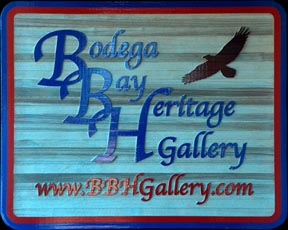 |
Bodega Bay Heritage Gallery Monthly Preview our new gallery exhibit |
1580 Eastshore Road, PO Box 325, Bodega Bay, CA 94923, 707-875-2911 (map) |
|
Homepage | Contact Us | Our Location
| A-B | C-D | E-G | H-He | Hi-J | K-M | N-P | Q-S | T-Z |
California/American School | Alpha Listings of Artists | Recent Acquisitions
Watercolors | Farm Scenes | Coastal | Deserts | Mountains | National Parks | Still Life & Portraits
Previous Issues 2007 | December | November | October | September | August | July | June | May | April
Previous Issues 2008 | February | January |
 |
Bodega Bay Heritage Gallery Monthly Preview our new gallery exhibit |
1580 Eastshore Road, PO Box 325, Bodega Bay, CA 94923, 707-875-2911 (map) |
|
In this issue: |
- Milford Zornes, Teacher and Artist Has Passed |
Milford Zornes, Teacher and Artist Has Passed, February 24, 2008 at age 100
Inland Valley Daily Bulletin: "A Genuine Artist" and slideshow
http://www.dailybulletin.com/news/ci_8363970
* * * * *
 Amgen Tour of California as it rolled into Bodega Bay ... photo by Daniel Rohlfing |
Bodega Bay Heritage Gallery salutes the 150 racers of the Amgen Tour of California. These extraordinary cyclists rolled through Bodega Bay on Monday, February 18 on the first leg of their 8 day 650 mile tour of California. The world's top professional teams began in Palo Alto south of San Francisco. On the second leg of the tour, they rode north through Bodega Bay, then east to Santa Rosa. The next legs of the race took them east to Sacramento, south to Modesto, west to Monterey and south, and ended in Pasadena on February 24. The tour visited many of the California scenes painted by a long heritage of California plein air painters. Through vineyards, past beaches, through redwoods, orchards, mountains and deserts, these athletes exhibited their incredible endurance and skill. Like California's painters, these cyclists showed off California in a most colorful and festive way. Like the swallows of Capistrano, Bodega Bay looks forward to their return. |
* * * * *
|
Bold Depictions of California and Californians WPA California Style Watercolors A Truly Californian Art Form |
|
When artists first came to the Golden State, their European training and traditions were used to interpret paintings of California’s natural beauty. But because California’s scenery was different from Europe and so diverse, California painting soon began to take on new styles and a Californian look better suited to this new land. |
||
In the realm of watercolor painting, this is especially true. At the turn of the twentieth century most of our early watercolor painters were trained in Europe or New York. Their watercolor paintings began as elaborate pencil drawings with areas of their compositions showing a high degree of detail. To these drawings were added carefully applied watercolor, rendering a tight appearance in the final painting.
|
||
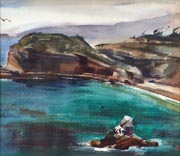 Maurice Logan |
But from the roaring mid 1920s through the post war mid 1950’s, watercolor painting in California took on a bold new look. Most artists used a large, full sheet format, with free ranging broad brush stokes of vivid color. They painted scenes of everyday California life, city street scenes, sights of industry, Californians in their daily work routine, and scenes of California beaches, harbors, and vast open landscapes, often showing farm and ranch livestock scenes. | |
| Watercolor artists in California established a statewide community by forming the California Watercolor Society in 1921. Artists including Marion Wachtel, Oscar Borg, William Ritschel, Karl Yens, Hanson Puthuff and Dana Bartlett formed their organization and began exhibiting their work together. But as the roaring twenties continued, some of the new bolder watercolor artists joined the CWS, and established their newer style among art lovers. Millard Sheets, Phil Dike, Lee Blair, Tom Craig, Barse Miller, Paul Sample, Hardie Gramatky and Emil Kosa Jr. were among the earlier practitioners of this new style. | 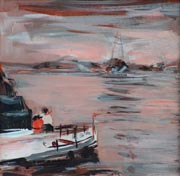 Phil Dike |
|
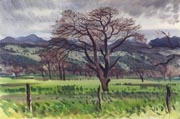 Milford Zornes |
They used pencil sketching very little, if at all, and often allowed the white paper to become a color value in their large 20” x 30” full sheet paintings. As their works accumulated, art critics and museum curators noticed this fresh, bold, and California regional style. Popular exhibitions of this work showed up all over America in both galleries and museums. | |
| All of California shared in the California style. In Northern California, San Franciscans George Post, Dong Kingman, and Maurice Logan preserved some fantastic scenes of the period of the city of San Francisco, the Bay, and the surrounding region. Back South, the movement attracted new adherents, Milford Zornes, Mary Blair, Ejnar Hansen and Standish Backus. | 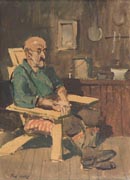 Paul Sample |
|
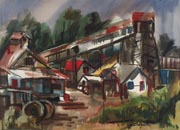 Lewis Suzuki |
Art cannot be separated from the times in which it was created. In the 1930’s the Great Depression colored the art world. During these desperate times, buyers did not exist, and artists could not make a living. Along came the WPA, the Works Progress Administration, which was set up to put Americans back to work rebuilding America’s infrastructure. People worked on a wide range of construction projects, building schools, post offices, bridges, roads, dams, and working on our national parks. Artists of all kinds were hired by the WPA to inspire workers to work hard and pull together to help rebuild America. Painting artists were used to paint large public murals and mosaics, and many of these were done using the new California style. Americans were depicted in these works of art being about the task of working together to rebuild the nation. | |
At this time, animation was establishing itself as part of the film industry. Walt Disney and other producers of animation employed California style artists to give an authentic feel to their films, what the artists often called “getting the smell of the place." Ralph Hulett was one such Disney artist who was quite skilled at this. |
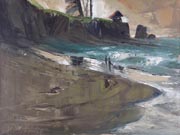 Ralph Hulett |
|
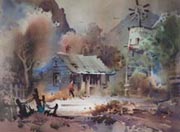 Robert Landry (San Diego Watercolor artist who worked as a staff artist for the Air Force and later the Pentagon) |
Again, world events intruded into the art world. World War II slowed and changed the California Style Watercolor movement. As people from all walks of life ceased peacetime endeavors and went to war, so too did the artists. Oftentimes, they had artistic duties in the military. Some of these watercolor artists made paintings of the action and were published to help give people a sense of what was happening in the war. Other artists worked on training films and did technical drawings for the military, while others created war related posters. |
|
| When the war ended, returning artists found the art world changing rapidly. Art schools swelled with hopeful GI students, and America was ready for a new reality, a peaceful expansion unparalleled in history. California art began to embrace newer abstract styles. Artists such as Alexander Nepote and Stanton McDonald Wright became key figures in the development of abstract art on the Pacific Coast. Some of the adherents of California Style Watercolors formed smaller organizations to preserve their California Style. Artists such as Maurice Logan, Rene Weaver, and Harold Gretzner formed a group in Northern California, while in the South, Emil Kosa Jr., Ralph Hulett and Standish Backus continued an effort to reestablish the form. | 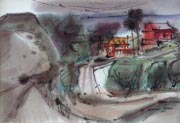 Alexander Nepote |
|
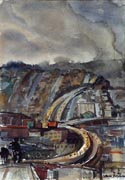 Thelma Speed Houston |
Today, there is a resurgence of appreciation for the WPA California Style Watercolor Movement and the artists who created it. In their time, they were bold statements of a contemporary California life, but today, they preserve for us scenes of a California busy building itself, growing in bold new diverse directions as diverse and bold as California’s geography. | |
| When Europeans first arrived, California was a land of promise, home of the California Dream. The scenes depicted in these California Style Watercolors exhibit the builders and scenes of that dream. It's a dream we’re reforming for ourselves, and touching base with the artists of the California Watercolor Movement can only inspire us to do our task well. | 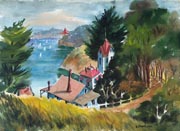 Elmer Stanhope |
|
* * * * *
CARE AND FRAMING OF COLLECTIBLE WATERCOLORS An exhibition of California Style Watercolors is a good opportunity to discuss some issues regarding the framing and preservation of older watercolors. Bodega Bay Heritage Gallery has as part of its mission statement to get the vintage paintings "ready for their next 100 years." This has particular applicability because when these watercolors were originally framed, people did not always understand about the effects of time, sunlight, and acid materials. It is very common when you take older watercolor framing apart to find lines of "matt burn", stain from cardboard, corrugated, or wood backing, and various harmful tapes and glues. |
* * * * *
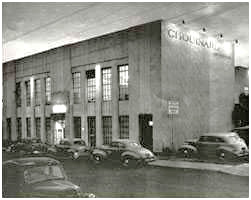 |
The Chouinard (shwee-nar) Institute 1921-1972 |
||
Yes, that’s the way it is pronounced. One of Los Angeles’ most influential art schools was founded in 1921 by a woman, Nelbert Murphy Chouinard, an artist and an educator on a mission to spread the joy of art. She once explained to The Literary Digest that the name of the institute, pronounced was “... oui as the French say “yes,” almost “shwee-nar.”
|
|||
In its prime, the institute was the teaching home of Millard Sheets and Phil Dike. Together, their artistic visions and teachings influenced a whole new generation of California Style watercolor artists. But the school had a much wider impact. In the field of animation, many of Chouinard grads were employed as Walt Disney animators. The school also influenced forms of west coast modernism, ceramics, pop art, and conceptualism, fashion design, architecture, and forms of surf and rock culture. The mission of the school was a grand experiment, a labor of love to offer art to the community. In 1961 with the assistance of Walt and Roy Disney, the Chouinard Institute merged with the Los Angeles Conservatory of Music to create the California Institute of the Arts. After Nelbert Murphy Chouinard died in 1969, the California Institute of the Arts closed in 1972. Over its tenure, the school had some 400 instructors and over 50,000 students, an amazingly talented and diverse community of artists who proudly called themselves "Chouinardians." |
|||
Gallery Notes
Booklets for our current exhibit, "California Style WPA Watercolors," and our previous exhibit, "Painters of the Desert" are available.
local West Sonoma County gallery happenings
At Local Color Gallery, which is in our same building, the large-scale paintings of Robert DeVee are on view and garnering very favorable attention with their pleasing and skillful qualities of depicting water scenes, often with boats - "Floating World" - much the same attraction as the lily-pad paintings by Monet.
The Ren Brown Collection up from us at the corner on Hwy 1 had a very successful participation in the Arts of Pacific Asia 2008 exhibition at the Fort Mason Center in San Francisco in early February. We visited it and were very impressed with the print images that were captivating many buyers. Their current show at their gallery is Recent Acquisitions.
Branscomb's bed & breakfast across the upper parking lot always has art on view.
West County Design in Valley Ford presents interesting crafted furniture and surfaces - see the inclusions tables across the street at Rocker Oysterfeller's bar area, and paintings by local artists. See also the original paintings at Rocker's.
Christopher Queen Galleries in Duncans Mills on the Russian River is about to present its annual "Frugal Collector" show, this year featuring contemporary tonalist painters. And of course there are the Early California gems upstairs as always.
Quercia Gallery in Duncans Mills will be presenting new sculptures by Bobbi Quercia, and has a show of quiet and subtle paintings by Ron Quercia of local beaches and foggy bay scenes - just the thing to bring a sense of calm and beauty to our home environments.
Quicksilver Mine Co. in Forestville will present works by Lauren Dicioccio.
Graton Gallery in Graton continues with its Invitational Exhibition 2 of 25 contemporary California artists.
| Coming in May & June '08 | |
California Paintings, |
|
* * * * *
|
|
|
Riverside |
Irvine California Mission, October 23 - March 15, 2008 http://www.irvinemuseum.org |
| Sacramento Permanent Exhibit: Early California Art Edwin Deakin: California Painters of the Picturesque Jan 28 - April 20, 2008 http://www.crockerartmuseum.org/exhibitions/permanent_california.htm |
Monterey |
Oakland |
Pasadena |
| Santa Rosa Rotating history gallery http://www.sonomacountymuseum.com |
Ukiah Grace Hudson permanent collection http://www.gracehudsonmuseum.org |
| San Francisco de Young Museum: American Painting Collection http://www.famsf.org |
Palm Springs Permanent collection: American Desert Painters http://www.psmuseum.org |
| San Diego Plein Air Pasts and Present: A Collaboration between SDMA and the Lux Art Institute http://www.sdmart.org |
Seattle Inspiring Impressionism: The Impressionists and the art of the past June through September, 2008 http://www.seattleartmuseum.org |